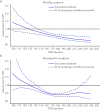Developments in Cardiac Resynchronisation Therapy
- PMID: 26835113
- PMCID: PMC4711555
- DOI: 10.15420/aer.2015.04.02.122
Developments in Cardiac Resynchronisation Therapy
Abstract
Cardiac resynchronisation therapy (CRT) is an important therapy for patients with heart failure with a reduced ejection fraction and interventricular conduction delay. Large trials have established the role of CRT in reducing heart failure hospitalisations and improving symptoms, left ventricular (LV) function and mortality. Guidelines from major medical societies are consistent in support of CRT for patients with New York Health Association (NYHA) class II, III and ambulatory class IV heart failure, reduced LV ejection fraction and QRS prolongation, particularly left bundle branch block. The current challenge facing practitioners is to maximise the rate of patients who respond to CRT and the magnitude of that response. Current areas of interest for achieving these goals include tailoring patient selection, individualising LV lead placement and application of new technologies and techniques for CRT delivery.
Keywords: Cardiac resynchronisation therapy; LV lead delivery; LV reverse remodelling; cardiac pacemaker; device programming; heart failure; implantable cardioverter/defibrillator; left bundle branch block; left ventricular function.
Figures



Similar articles
-
Tailoring cardiac resynchronisation therapy to non-left bundle branch block: Successful cardiac resynchronisation for right bundle branch block with left posterior fascicular block without implantation of a left ventricular lead.Indian Pacing Electrophysiol J. 2022 Jul-Aug;22(4):207-211. doi: 10.1016/j.ipej.2022.04.002. Epub 2022 Apr 12. Indian Pacing Electrophysiol J. 2022. PMID: 35427783 Free PMC article.
-
Cardiac resynchronization therapy in patients with end-stage inotrope-dependent class IV heart failure.Am J Cardiol. 2007 Jul 1;100(1):90-3. doi: 10.1016/j.amjcard.2007.02.058. Epub 2007 May 15. Am J Cardiol. 2007. PMID: 17599447 Clinical Trial.
-
Cardiac resynchronization therapy in patients with chronic heart failure: pathophysiology and current experience.Am J Cardiovasc Drugs. 2002;2(4):219-26. doi: 10.2165/00129784-200202040-00001. Am J Cardiovasc Drugs. 2002. PMID: 14727967 Review.
-
Echocardiographic evaluation of patients with severe heart failure and impairment of intraventricular conduction following cardiac resynchronisation therapy.Kardiol Pol. 2008 Apr;66(4):396-403; discussion 404-5. Kardiol Pol. 2008. PMID: 18473268
-
Does cardiac resynchronisation therapy improve survival and quality of life in patients with end-stage heart failure?Interact Cardiovasc Thorac Surg. 2008 Dec;7(6):1141-6. doi: 10.1510/icvts.2008.183707. Epub 2008 Jun 9. Interact Cardiovasc Thorac Surg. 2008. PMID: 18541605 Review.
Cited by
-
His-bundle Pacing as a Bailout Therapy for a Patient with Subclavian Stenosis and No Suitable Coronary Sinus Branch: A Double Whammy.J Innov Card Rhythm Manag. 2022 Sep 15;13(9):5159-5163. doi: 10.19102/icrm.2022.130902. eCollection 2022 Sep. J Innov Card Rhythm Manag. 2022. PMID: 36196239 Free PMC article.
-
Usefulness of Biomarkers for Predicting Response to Cardiac Resynchronization Therapy.Curr Cardiol Rev. 2020;16(2):132-140. doi: 10.2174/1573403X15666191206163846. Curr Cardiol Rev. 2020. PMID: 31822259 Free PMC article. Review.
-
Automated Classification of Severity in Cardiac Dyssynchrony Merging Clinical Data and Mechanical Descriptors.Comput Math Methods Med. 2017;2017:3087407. doi: 10.1155/2017/3087407. Epub 2017 Feb 19. Comput Math Methods Med. 2017. PMID: 28348637 Free PMC article.
References
-
- Prinzen FW, Vernooy K, Auricchio A. Cardiac resynchronization therapy: state-of-the-art of current applications, guidelines, ongoing trials, and areas of controversy. Circulation. 2013;128:2407–18. - PubMed
-
- Daubert JC, Saxon L, Adamson PB et al. 2012 EHRA/HRS expert consensus statement on cardiac resynchronization therapy in heart failure: implant and follow-up recommendations and management. Europace. 2012;14:1236–86. - PubMed
-
- Cazeau S, Leclercq C, Lavergne T et al. Effects of multisite biventricular pacing in patients with heart failure and intraventricular conduction delay. N Engl J Med. 2001;344:873–80. - PubMed
-
- Abraham WR, Fisher WG, Smith A et al. Cardiac resynchronization in chronic heart failure. N Engl J Med. 2002;346:1845–53. - PubMed
-
- Bristow MR, Saxon LA, Boehmer J et al. Cardiac-resynchronization therapy with or without an implantable defibrillator in advanced chronic heart failure. N Engl J Med. 2004;350:2140–50. - PubMed
LinkOut - more resources
Full Text Sources
Other Literature Sources
Research Materials

